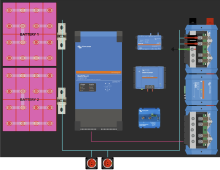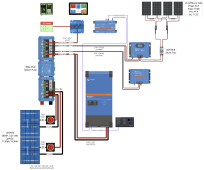Firstascent
Solar Enthusiast
- Joined
- Mar 7, 2020
- Messages
- 265
Hey everyone,
The attached drawing shows a quick sketch of the current planned cable path from my batteries to my DC Distribution and then on to my Inverter.
The devices are to scale and the big dark gray area you can assume is the area I have to work with.
Does anyone see any issues with the cable lengths here for my main runs?
1. Each battery will be wired to a ON/OFF switch, and then joined at the Lynx Distribution
2. The blue cable lengths from the BATTERY -> DISTRIBUTION is about 7.5', they will be equal lengths
This is the general physical layout I'm currently considering so wanted to reach out before I started building the mounting points for everything.
Assume I would prefer the Lynx Distribution in the bottom right corner as-is, and the batteries on the left side.
All constructive criticism welcome

The attached drawing shows a quick sketch of the current planned cable path from my batteries to my DC Distribution and then on to my Inverter.
The devices are to scale and the big dark gray area you can assume is the area I have to work with.
Does anyone see any issues with the cable lengths here for my main runs?
1. Each battery will be wired to a ON/OFF switch, and then joined at the Lynx Distribution
2. The blue cable lengths from the BATTERY -> DISTRIBUTION is about 7.5', they will be equal lengths
a. The total of 2 pairs (4 wires) will all be 2/0 Ancor tinned copper cable
b. I show one blue line but each battery is not connected to each other until the busbar at the distribution
3. The cable lengths from the DISTRIBUTION -> INVERTER is about 2.5'a. The total of 1 pair (2 wires) will be 4/0 Ancor tinned copper cable
4. The ON/OFF switches are purposely outside the box, I want to have quick access to them if needed.This is the general physical layout I'm currently considering so wanted to reach out before I started building the mounting points for everything.
Assume I would prefer the Lynx Distribution in the bottom right corner as-is, and the batteries on the left side.
All constructive criticism welcome

Last edited:




